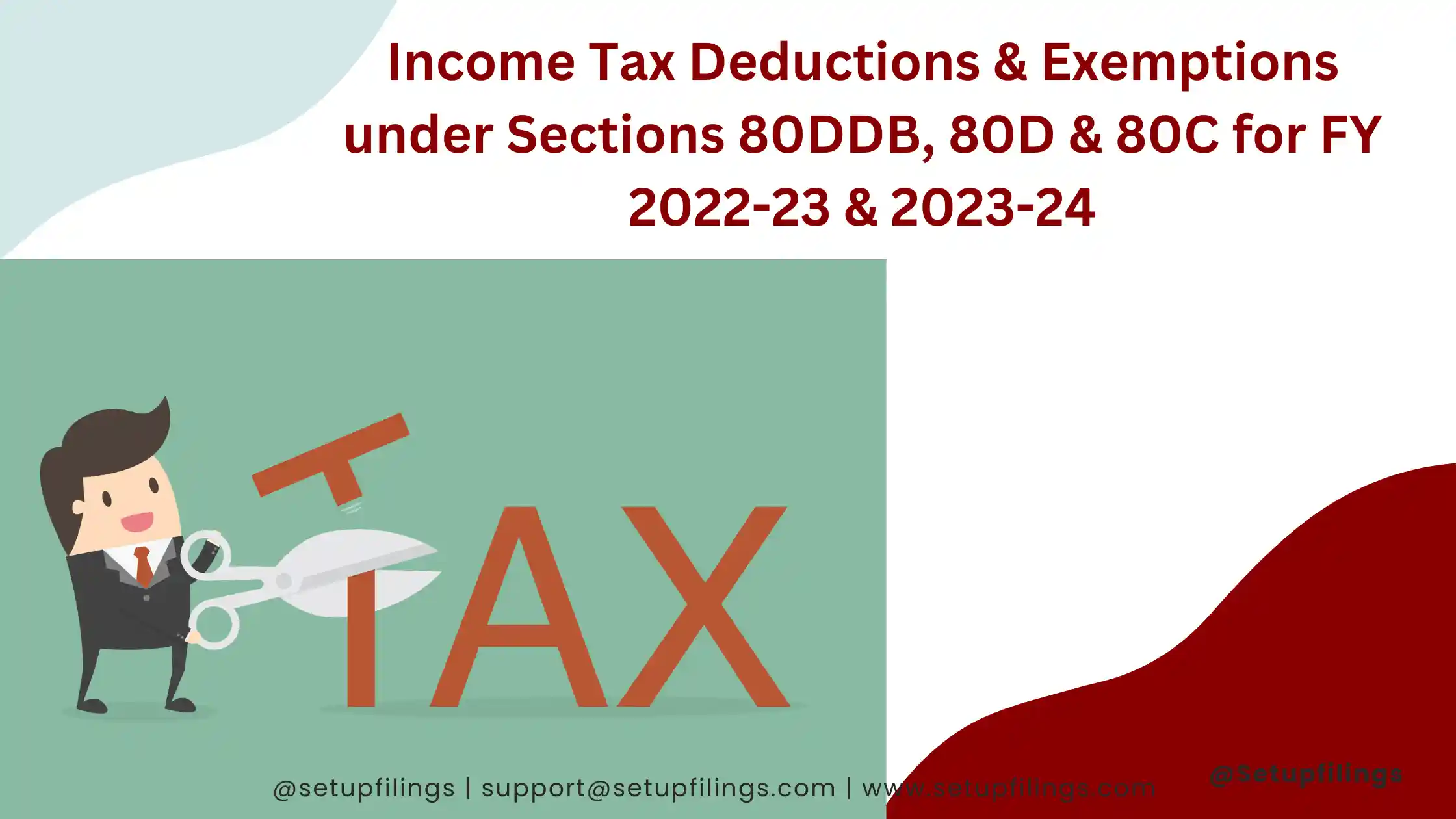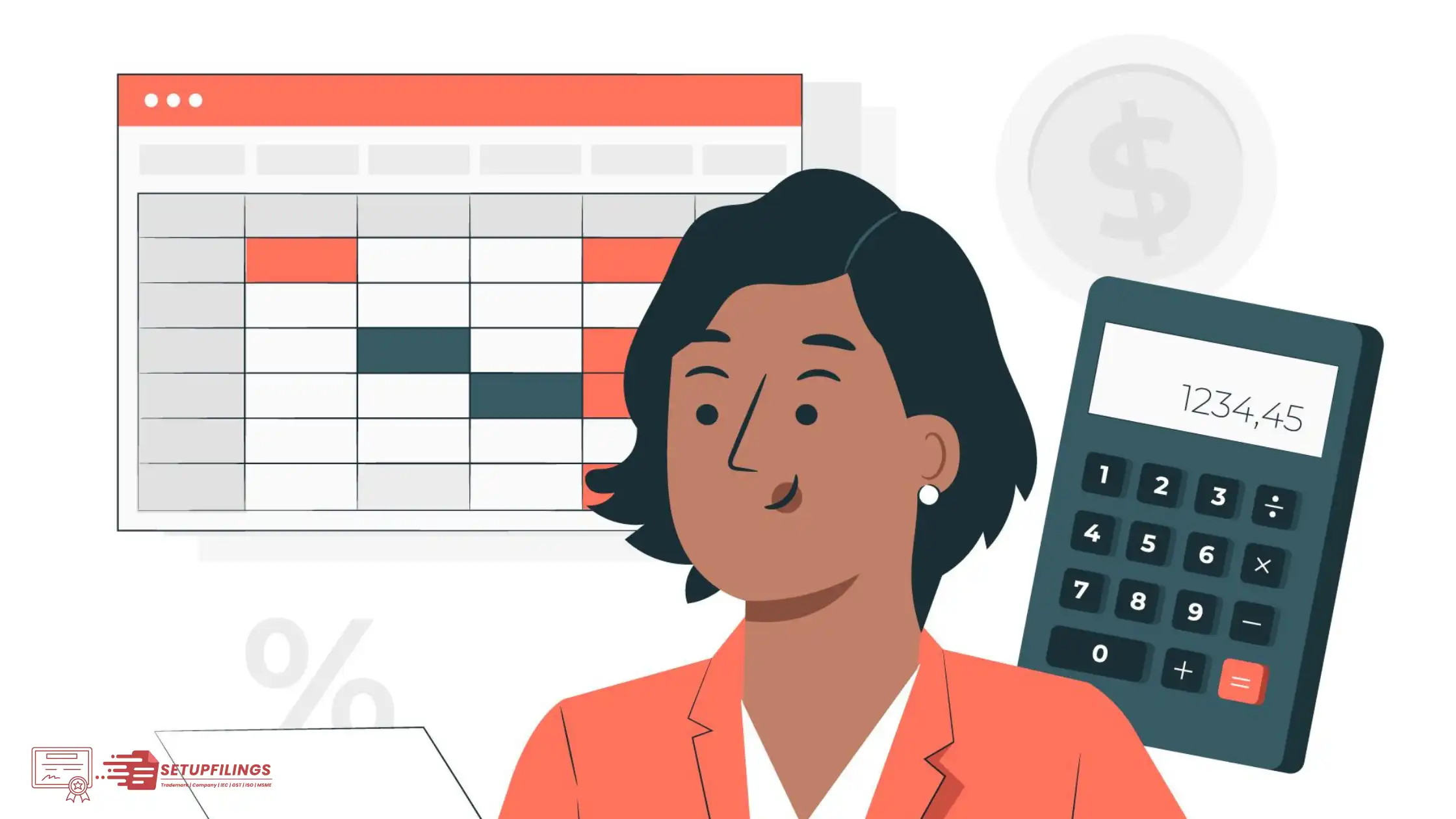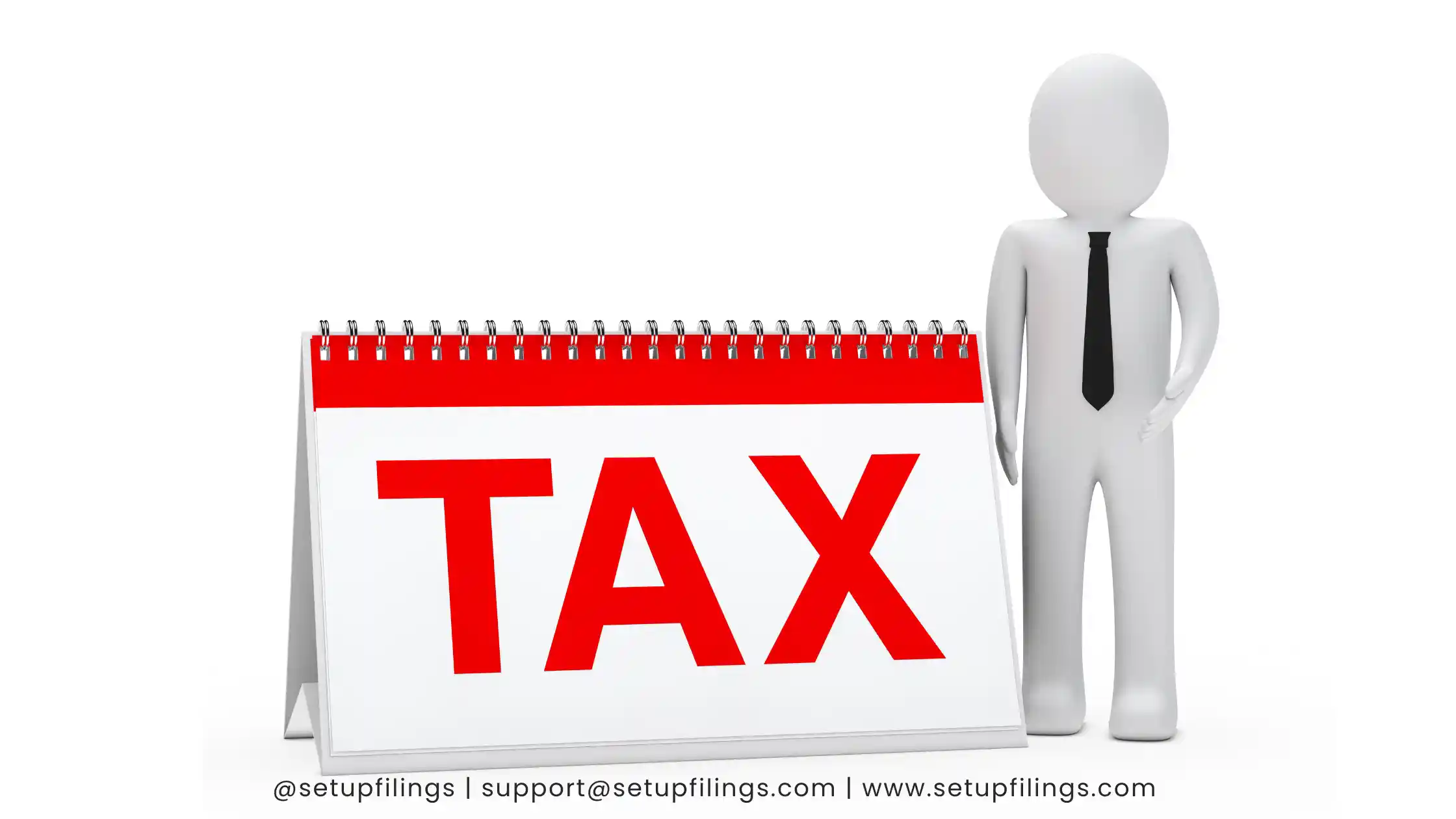
Income Tax Deduction & Exemptions Explained
Income tax filing is one of the most critical chores for each Indian citizen, whether they are salaried or company owners. In light of this, the Finance Ministry of India issues a budget each year outlining the dos and don’ts of Income tax deduction. Simultaneously, every citizen is perplexed about making an investment that will help them save taxes.
Income Tax Deduction & Exemptions under Sections 80C, 80D & 80DDB for FY 2022-23 & 2023-24.
Although it may appear that everyone must pay some amount of tax each year, there are a few ways to save taxes or receive a rebate. PPF, EPF, and other tax-saving investment choices are widely employed, and they provide tax exemption under section 80C. Similarly, other areas may help you save taxes, although you may not realise it.
Income Tax deduction Slab for individuals/Proprietor below the age of 60 (Rs. 2.5 Lakh of Income Tax Exemption is allowed) for FY 2022-232
Individual Income tax below the Age of 80 Year but above the Age of 60 years (Rs. 3 Lakh of Income tax exemption is allowed) for FY 2022-232
Individual Income tax deduction Above the Age of 80 years (Rs. 5 Lakh of Income tax exemption is allowed) for FY 2022-232
Salaried Employee Income Tax Exemptions 2022 – 23
The new tax regime has the same tax rates for all categories. Individuals and HUF under the age of 60, senior citizens above the age of 60, and super senior citizens over the age of 80 are all eligible. As a result, the basic exemption limit benefit for senior and super-senior persons has not been increased.
Taxpayers now have two options: they may either accept the new tax system and pay income tax at reduced rates without a few income tax exemptions and deductions, or they can opt out. Alternatively, they can maintain the old tax regime and pay higher rates while benefiting from certain deductions and exemptions.
However, the new tax regime allows for a few deductions. These are their names:
Individuals with special needs can receive transport allowance, which is considered a deduction. Travel expenditures to and from work will be considered a conveyance allowance. Investment in the NPS or Notified Pension Scheme will be deducted under Section 80CCD (2). There are deductions available for newly appointed workers under Section 80JJAA. Depreciation of assets (equipment) under Section 32, excluding additional depreciation charges incurred by personnel who are moved or travelling for work.
The new tax structure does not include 70 exemptions and deductions. The following are the most typical exclusions from this list:
Professional tax, House Rent Allowance (HRA), Children’s Education Allowance (CEA), Leave Travel Allowance (LTA), daily expenditures incurred during work relocation allowance, and Conveyance Allowance (under Section 24). Other special allowances [Section 10(14)] assistant allowance normal salary deduction.
Income Tax Exemptions for Salaried Employees 2022–23
Section 80C – Investment Deductions
Section 80C is one of the most well-liked and popular sections among taxpayers since it allows them to reduce their taxable income by making tax-saving investments or incurring eligible charges. The maximum yearly deduction from taxable income is Rs. 1.5 lakh.
- Individuals and HUFs can both take advantage of this discount.
- This deduction is not available to company, partnerships, or LLPs.
- Section 80C includes subsections 80CCC, 80CCD (1), 80CCD (1b), and 80CCD.
- The entire deduction limit, including subsections, is 1.5 lakh, with the exception of an extra deduction of 50,000 allowed under Section 80CCD (1b).
Section 80D – Medical Insurance Deduction For Premiums Paid
Section 80D permits you (as an individual or HUF) to deduct $25,000 for health insurance for yourself, your spouse, and any dependent children. You may additionally deduct an extra 25,000 from your parents’ insurance if they are under the age of 60. This amount was increased from 30,000 to 50,000 in the 2018 Budget for parents over the age of 60. The maximum deduction permitted by this provision is $100,000 if both the taxpayer and the taxpayer’s parent(s) are 60 or older.
Section 80DDB – Medical Expenses
Medical Expenses For Oneself Or A Dependent Relative:
- A Deduction For People Under 60.
A resident person or a HUF may deduct up to $40,000 in taxes. It can be used to cover the price of treating specified medical disorders for the owner or any of his dependents. A HUF may make such a deduction for medical expenses linked to certain specified diseases for any HUF member.
- For the very elderly and the elderly
If the elderly person for whose benefit the expenditures were incurred, the individual or HUF taxpayer may claim a deduction of up to $100,000. A senior citizen and a super senior citizen may claim a discount of 60,000 and 80,000 respectively until FY 2017-18. Unlike in the past, this is now a standard deduction offered to all seniors, including super seniors, up to $100,000.
Any reimbursement of medical expenses by an insurance company or an employer reduces the amount of the deduction that the taxpayer may claim under this section.
- For reimbursement claims
Also, keep in mind that in order to claim such a deduction, you must have a prescription from the appropriate physician. Look over our in-depth article on Section 80DDB.
There is another a 10% surcharge if the overall income surpasses $50,000,000, and a 15% surcharge if the entire income exceeds one crore. A 3% education cess is also levied in addition to the surcharge.
The income tax exemption level for all persons under the age of 60 is $250,000; for those between the ages of 60 and 80, it is $300,000; and for individuals above 80, it is 500,000.
Every person is entitled for a tax deduction for income invested in particular securities. We have included all of the deductions for Fiscal Year 2019-20 to assist you conveniently file your income tax returns and maximise the available tax deductions.
The following is a list of income tax deductions for fiscal years 2022-23 and 2023-24 based on different parts of the Income Tax Act of 1961:
1. Section 80C Income Tax Deduction
For every taxpayer, this is the most important part for deductions. The section’s maximum exemption limit is $15,000,000. Section 80C allows for the claim of various routes such as PPF, EPF, term insurance, NPS, and so forth. The whole list is as follows:
- National Provident Fund
- National Savings Certificate
- National Pension Plan
- Provident Fund for Employees
- Tuition costs
- Postal Service tax-advantaged deposits
- Bank deposit for five years
- Insurance Premium
- Equity-Linked Savings Plans
- Sukanya Samriddhi Account Deposit Scheme
- Post Office Senior Citizens Savings Plan
2. Section 80CCC Income Tax Deduction
This provision provides a maximum deduction of $500,000 and includes contributions made to a life insurance provider’s annuity plan in order to receive a pension from the fund.
3. Section 80CCD Income Tax Deduction
The contribution to the Atal Pension Yojana is included in this section. It provides for contributions to government-notified pension systems of up to 10% of total compensation for paid employees and 20% of gross income for non-salaried employees. Section 80 CCD (1) allows the donation to be deducted from taxable income. If the employer additionally contributes to the scheme, the whole contribution amount is deductible under Section 80CCD (2).
It is vital to recall that the total deduction under Sections 80C, 80CCC, and 80CCD (1) cannot exceed $15,000,000. However, the additional tax deduction of $50,000 allowed under Section 80CCD (1B) exceeds this limit.
4. Section 80D Income Tax Deduction
Section 80D provides an income tax deduction for medical insurance premiums paid. This part permits individuals and HUFs to deduct their health insurance premiums. You can claim a deduction of up to 25,000 for yourself, your spouse, and your dependent children, as well as an extra deduction of up to 25,000 for insurance coverage for parents under the age of 60. Parents over the age of 60 can claim a deduction of 50,000, which was doubled from 30,000 in Budget 2018.
Furthermore, if the taxpayer and parent(s) are over the age of 60, the maximum deduction under section 80D is up to $1,000,000.
5. Section 80DD Income Tax Deduction
A deduction of $75,000 may be claimed for medical expenses incurred by dependents with a 40% disability. In the case of serious handicap, the maximum is $1,25,000.
6. Section 80DDB Income Tax Deduction
Medical Expense Deduction for Self or Dependent Relative: Deduction for Medical Expenses for Individuals and HUFs Under the Age of 60. Individuals and HUFs under the age of 60 can claim an income tax deduction of up to 40,000 under Section 80DDB. It is for any costs incurred in treating identified serious illnesses for oneself and dependents. Medical Expense Deduction for Senior Citizens and Super Senior Citizens. Previously, the limit for senior citizens was 60,000 in fiscal year 2017-18.
7. Section 80CCG Income Tax Deduction
This component, which provided tax benefits through the Rajiv Gandhi Equity Savings Scheme, has been removed. However, if you claimed a deduction in the previous fiscal year, you are eligible to continue doing so for the next two fiscal years.
8. Section 24B Income Tax Deduction
Individuals can claim a deduction for the loss under the heading Income from House Property under this provision. It allows for a tax deduction of up to $2,000 on the repayment of a second mortgage. Unclaimed loss can be carried forward for eight years and deducted from house property income. Any interest paid on the housing loan is also tax deductible.
9. Section 80E Income Tax Deduction
Section 80E applies to interest on educational loans. Please keep in mind that loan principle repayment cannot be deducted. The loan should have been taken out for yourself, your children, and your spouse, or for someone over whom you have legal custody.
10. Section 80U Income Tax Deduction
Individuals who are physically or mentally challenged are eligible for a deduction under this section. Salaried Employee Income Tax Exemptions 2022-23. Here is the list of income tax exemptions for 2022-23: including broadband, and cell phone
11. Section 80EE Income Tax Deduction
Individuals purchasing their first home may claim an additional deduction of $50,000 for home loan interest paid. This includes a requirement that the loan be sanctioned in or after fiscal year 2016-17, and that the loan amount be less than $35,000. Furthermore, the house’s value cannot exceed $50,000, and the individual cannot own any other residential property.
- Housing Allowance
- LTA (Leave Travel Allowance)
- Food vouchers
- Component of salary 5. Reimbursements
- Proof
- HRA (housing rent allowance)
- Rent for a single-family home
- Rent receipts and the employer’s PAN (required if the rent exceeds one lakh rupees per year).
- LTA (leave travel allowance)
- Domestic travel expenses, such as flight and rail price
- Airline and rail tickets, as well as bus or taxi receipts/bills
- Phone reimbursement
- Telephone bills, no. 15
- Books and magazines.
12. Section 80EEA Income Tax Deduction
Section 80EEA provides for a deduction of up to $15,000 for interest payments. This deduction is in addition to the $200,000 deduction provided under Section 24. To claim this deduction, a person must not own a home on the day the loan is approved.
13. Income Tax Deduction Under Section 80G
Section 80G includes all charity contributions and disaster relief funding. The contribution should be made in the form of a cheque, cash or draught. The maximum allowable deduction is $2,000. Furthermore, the same deduction could be claimed under 80GGC for donations made to political parties.
14. Section 80GG Income Tax Deduction
The deduction amount for this part is 60,000 per year, and it only applies to people who do not own a home or get a House Rent Allowance. As a result, the deduction will be the smallest of the following:
25% of overall earnings 5,000 per month, or 10% of adjusted total income subtracted from rent paid.
15. Section 80TTA Income Tax Deduction
This clause permits individuals or Hindu Undivided Families to deduct $10,000 from their total gross income. The interest generated on deposits placed in a savings account at a bank, cooperative society, or post office is deductible. The deduction, however, will not be applied.
Visited 221 Times, 1 Visit today


